EZ Mouthpiece Electronics
 Here's a circuit that uses a single op amp to implement an electronic mouthpiece (breath-pressure sensor). It works by optically sensing the position of a diaphragm that moves in response to pressure changes. The component values depend on the physical placement of the optoelectronic parts and on the intensity of the light source as well as the sensitivity of the phototransistor, so the resistor values given may need to be modified somewhat.
Here's a circuit that uses a single op amp to implement an electronic mouthpiece (breath-pressure sensor). It works by optically sensing the position of a diaphragm that moves in response to pressure changes. The component values depend on the physical placement of the optoelectronic parts and on the intensity of the light source as well as the sensitivity of the phototransistor, so the resistor values given may need to be modified somewhat.
The light path from the LED D1 to the phototransistor Q1 is progressively blocked as the breath pressure increases. The best geometric arrangement to use is one where the moving diaphragm pushes against an optical stop (or vane) that travels between D1 and Q1. The stop can be as simple as a piece of stiff paper glued to the diaphragm. This geometry allows D1 and Q1 to be close together, producing a strong photocurrent signal in Q1.
Adjust the circuit as follows: With no breath pressure the light beam is unimpeded and the photocurrent produced in Q1 should raise its emitter voltage to somewhere in the 4-9 V range. If it's much larger than this, either reduce R2 or move D1 and Q1 farther apart. If it's much smaller, first make sure D1 and Q1 are as close together as practical, then if necessary increase R2. At full breath pressure the light path should be totally blocked and Q1's emitter should be close to 0 V.
The op amp circuit is a combination inverter, amplifier and rectifier. R4 and R5 provide an offset voltage so the circuit's output is 0 V at zero pressure. Actually R4 is adjusted slightly beyond the point where the output goes to zero, to allow for temperature drift in Q1's output. D2 clamps the final output so that it cannot go negative. The gain adjustment R7 is set so the total output swing is 5 V.
This is an easy circuit to set up and experiment with, but the temperature effects on D1 and Q1 can be problematic. "Burying" the the zero pressure signal well below the rectifier threshold (using R4) helps greatly, but for serious work a balanced or compensated design is more accurate and stable.
Back Home
 Here's a circuit that uses a single op amp to implement an electronic mouthpiece (breath-pressure sensor). It works by optically sensing the position of a diaphragm that moves in response to pressure changes. The component values depend on the physical placement of the optoelectronic parts and on the intensity of the light source as well as the sensitivity of the phototransistor, so the resistor values given may need to be modified somewhat.
Here's a circuit that uses a single op amp to implement an electronic mouthpiece (breath-pressure sensor). It works by optically sensing the position of a diaphragm that moves in response to pressure changes. The component values depend on the physical placement of the optoelectronic parts and on the intensity of the light source as well as the sensitivity of the phototransistor, so the resistor values given may need to be modified somewhat.